Change Plan: Transition Management for Coca-Cola Corporation
VerifiedAdded on 2023/01/20
|7
|960
|26
Report
AI Summary
This report provides a comprehensive analysis of change management within the Coca-Cola Company. It begins by examining the internal and external factors influencing the need for change, utilizing SWOT and PESTEL analyses to assess the business environment. Internal factors such as production processes, organizational skills, and communication networks are considered, alongside external factors including consumer perceptions, economic stability, and demographic patterns. The report then delves into the development of a change plan, outlining eight key steps for effective organizational transition. These steps include identifying areas for improvement, presenting a solid business case to stakeholders, providing resources, establishing communication strategies, managing resistance, celebrating success, and continuous improvement. The report emphasizes the importance of adaptability and proactive strategies in the face of evolving market dynamics and consumer expectations. The findings are supported by various references.
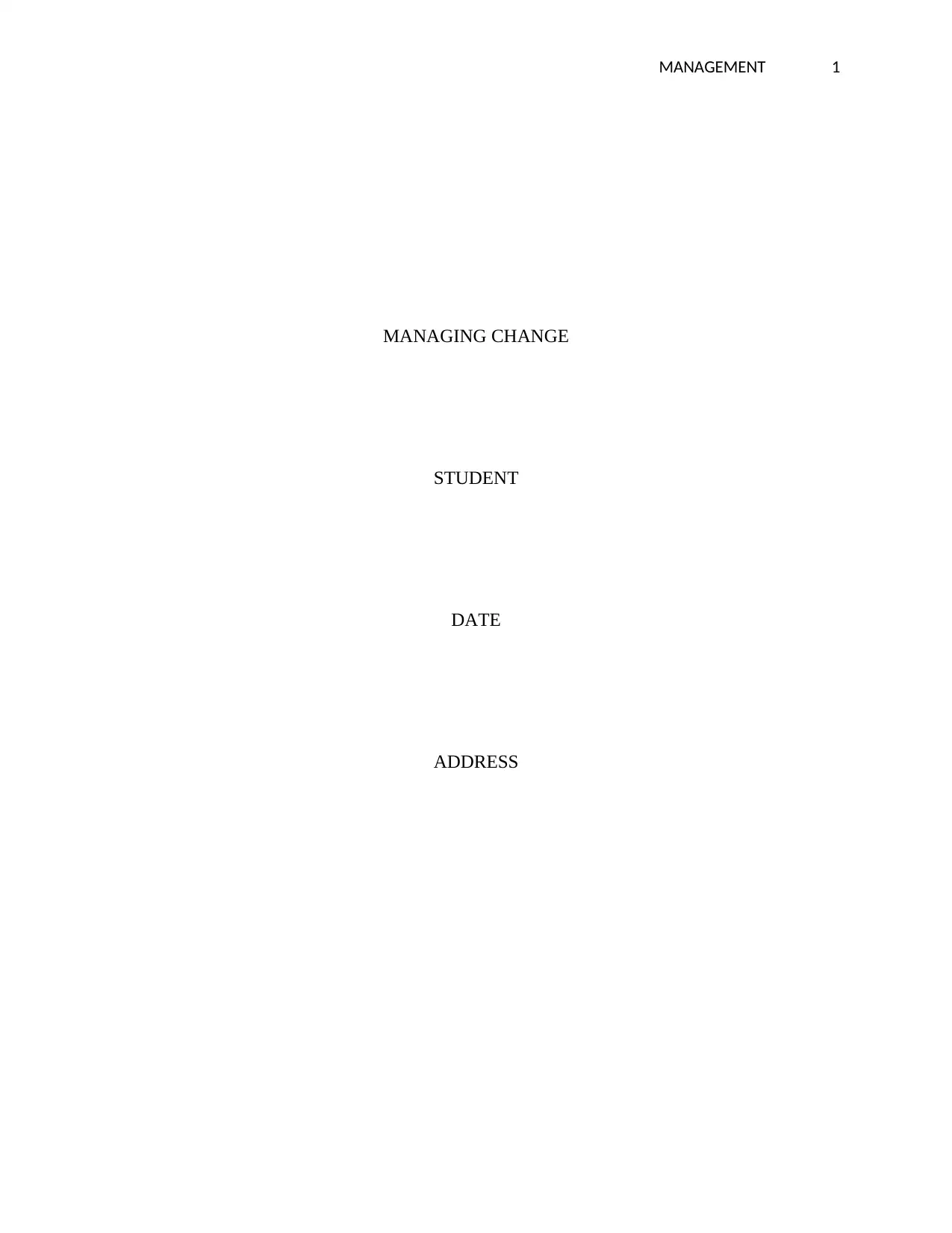
MANAGEMENT 1
MANAGING CHANGE
STUDENT
DATE
ADDRESS
MANAGING CHANGE
STUDENT
DATE
ADDRESS
Paraphrase This Document
Need a fresh take? Get an instant paraphrase of this document with our AI Paraphraser
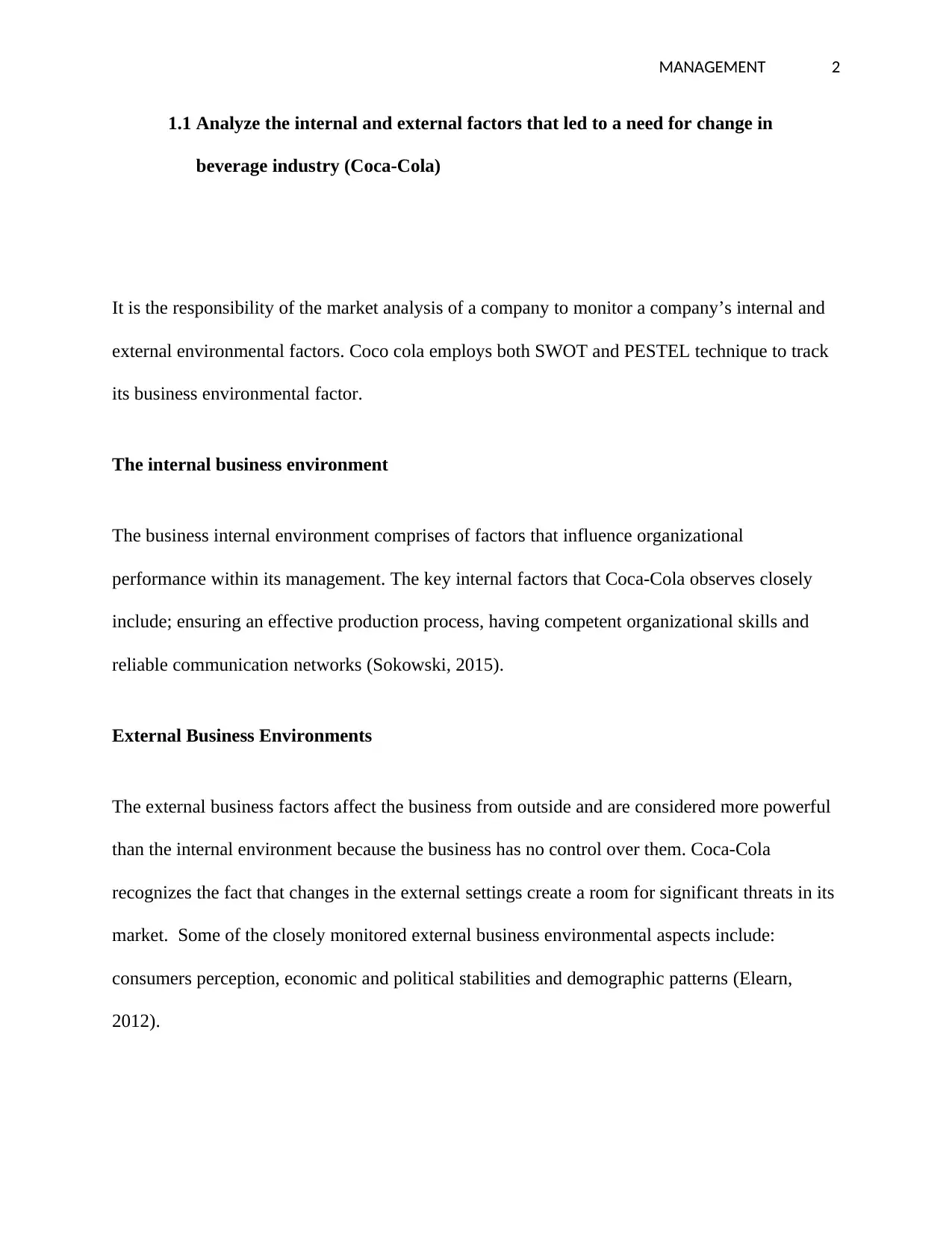
MANAGEMENT 2
1.1 Analyze the internal and external factors that led to a need for change in
beverage industry (Coca-Cola)
It is the responsibility of the market analysis of a company to monitor a company’s internal and
external environmental factors. Coco cola employs both SWOT and PESTEL technique to track
its business environmental factor.
The internal business environment
The business internal environment comprises of factors that influence organizational
performance within its management. The key internal factors that Coca-Cola observes closely
include; ensuring an effective production process, having competent organizational skills and
reliable communication networks (Sokowski, 2015).
External Business Environments
The external business factors affect the business from outside and are considered more powerful
than the internal environment because the business has no control over them. Coca-Cola
recognizes the fact that changes in the external settings create a room for significant threats in its
market. Some of the closely monitored external business environmental aspects include:
consumers perception, economic and political stabilities and demographic patterns (Elearn,
2012).
1.1 Analyze the internal and external factors that led to a need for change in
beverage industry (Coca-Cola)
It is the responsibility of the market analysis of a company to monitor a company’s internal and
external environmental factors. Coco cola employs both SWOT and PESTEL technique to track
its business environmental factor.
The internal business environment
The business internal environment comprises of factors that influence organizational
performance within its management. The key internal factors that Coca-Cola observes closely
include; ensuring an effective production process, having competent organizational skills and
reliable communication networks (Sokowski, 2015).
External Business Environments
The external business factors affect the business from outside and are considered more powerful
than the internal environment because the business has no control over them. Coca-Cola
recognizes the fact that changes in the external settings create a room for significant threats in its
market. Some of the closely monitored external business environmental aspects include:
consumers perception, economic and political stabilities and demographic patterns (Elearn,
2012).
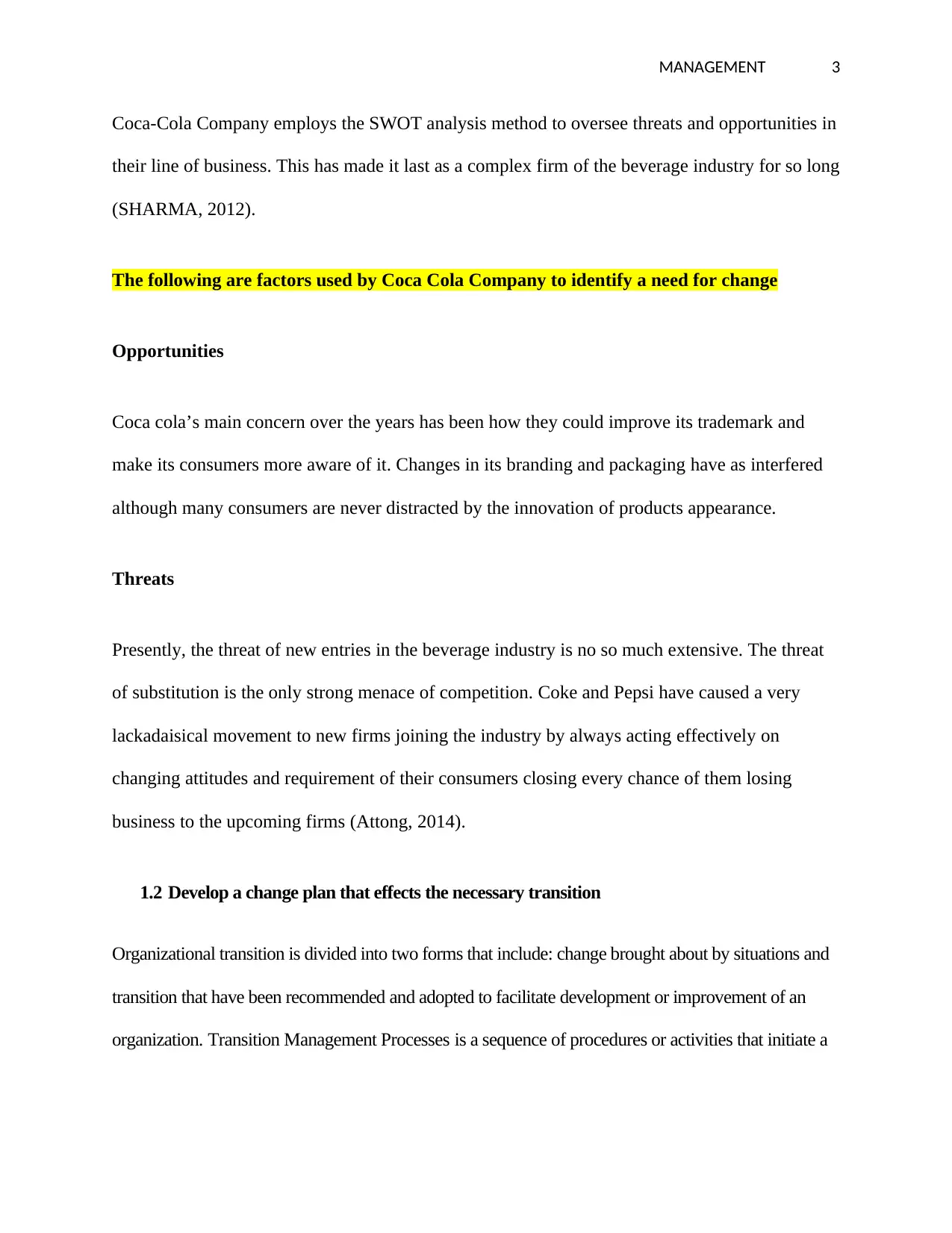
MANAGEMENT 3
Coca-Cola Company employs the SWOT analysis method to oversee threats and opportunities in
their line of business. This has made it last as a complex firm of the beverage industry for so long
(SHARMA, 2012).
The following are factors used by Coca Cola Company to identify a need for change
Opportunities
Coca cola’s main concern over the years has been how they could improve its trademark and
make its consumers more aware of it. Changes in its branding and packaging have as interfered
although many consumers are never distracted by the innovation of products appearance.
Threats
Presently, the threat of new entries in the beverage industry is no so much extensive. The threat
of substitution is the only strong menace of competition. Coke and Pepsi have caused a very
lackadaisical movement to new firms joining the industry by always acting effectively on
changing attitudes and requirement of their consumers closing every chance of them losing
business to the upcoming firms (Attong, 2014).
1.2 Develop a change plan that effects the necessary transition
Organizational transition is divided into two forms that include: change brought about by situations and
transition that have been recommended and adopted to facilitate development or improvement of an
organization. Transition Management Processes is a sequence of procedures or activities that initiate a
Coca-Cola Company employs the SWOT analysis method to oversee threats and opportunities in
their line of business. This has made it last as a complex firm of the beverage industry for so long
(SHARMA, 2012).
The following are factors used by Coca Cola Company to identify a need for change
Opportunities
Coca cola’s main concern over the years has been how they could improve its trademark and
make its consumers more aware of it. Changes in its branding and packaging have as interfered
although many consumers are never distracted by the innovation of products appearance.
Threats
Presently, the threat of new entries in the beverage industry is no so much extensive. The threat
of substitution is the only strong menace of competition. Coke and Pepsi have caused a very
lackadaisical movement to new firms joining the industry by always acting effectively on
changing attitudes and requirement of their consumers closing every chance of them losing
business to the upcoming firms (Attong, 2014).
1.2 Develop a change plan that effects the necessary transition
Organizational transition is divided into two forms that include: change brought about by situations and
transition that have been recommended and adopted to facilitate development or improvement of an
organization. Transition Management Processes is a sequence of procedures or activities that initiate a
⊘ This is a preview!⊘
Do you want full access?
Subscribe today to unlock all pages.

Trusted by 1+ million students worldwide
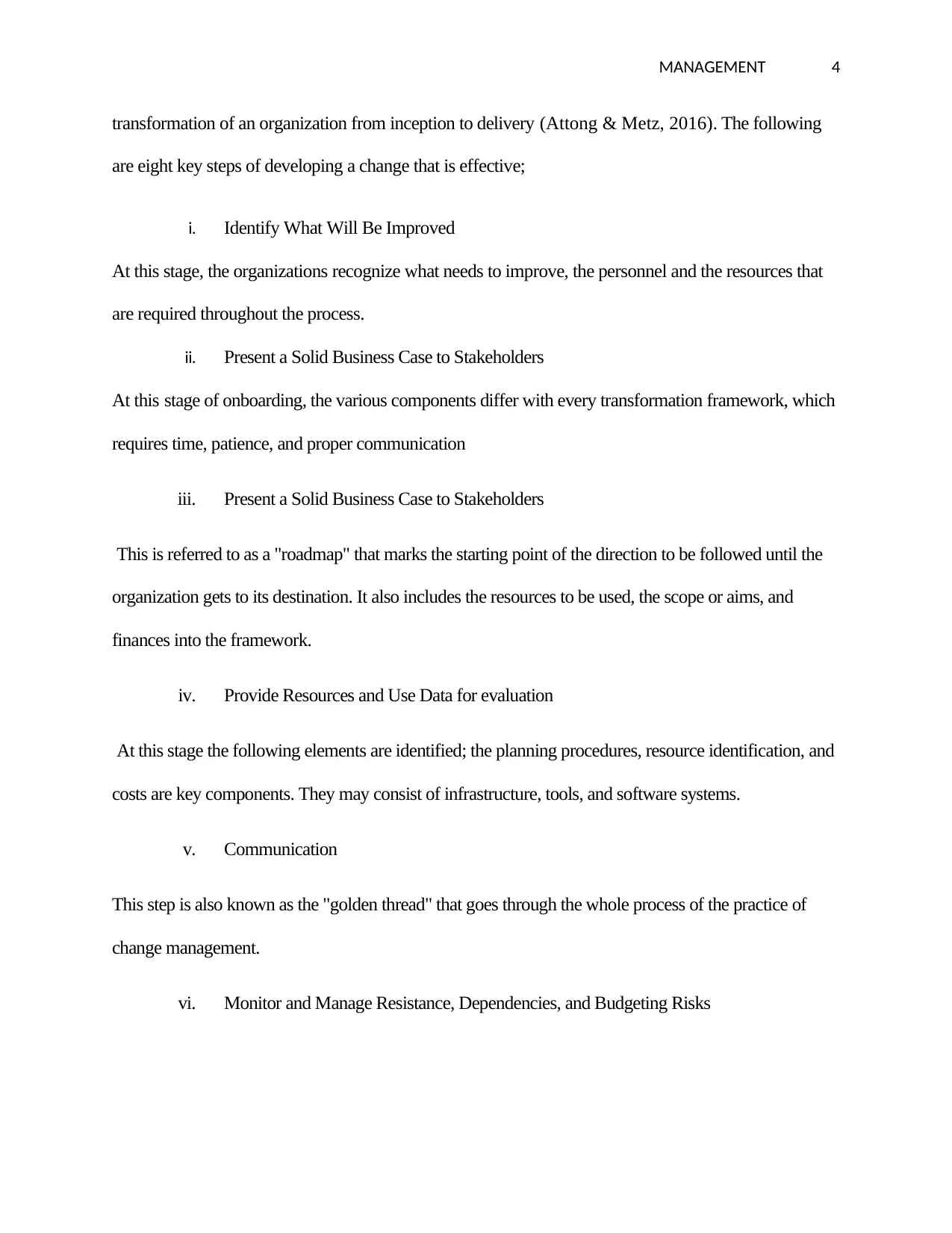
MANAGEMENT 4
transformation of an organization from inception to delivery (Attong & Metz, 2016). The following
are eight key steps of developing a change that is effective;
i. Identify What Will Be Improved
At this stage, the organizations recognize what needs to improve, the personnel and the resources that
are required throughout the process.
ii. Present a Solid Business Case to Stakeholders
At this stage of onboarding, the various components differ with every transformation framework, which
requires time, patience, and proper communication
iii. Present a Solid Business Case to Stakeholders
This is referred to as a "roadmap" that marks the starting point of the direction to be followed until the
organization gets to its destination. It also includes the resources to be used, the scope or aims, and
finances into the framework.
iv. Provide Resources and Use Data for evaluation
At this stage the following elements are identified; the planning procedures, resource identification, and
costs are key components. They may consist of infrastructure, tools, and software systems.
v. Communication
This step is also known as the "golden thread" that goes through the whole process of the practice of
change management.
vi. Monitor and Manage Resistance, Dependencies, and Budgeting Risks
transformation of an organization from inception to delivery (Attong & Metz, 2016). The following
are eight key steps of developing a change that is effective;
i. Identify What Will Be Improved
At this stage, the organizations recognize what needs to improve, the personnel and the resources that
are required throughout the process.
ii. Present a Solid Business Case to Stakeholders
At this stage of onboarding, the various components differ with every transformation framework, which
requires time, patience, and proper communication
iii. Present a Solid Business Case to Stakeholders
This is referred to as a "roadmap" that marks the starting point of the direction to be followed until the
organization gets to its destination. It also includes the resources to be used, the scope or aims, and
finances into the framework.
iv. Provide Resources and Use Data for evaluation
At this stage the following elements are identified; the planning procedures, resource identification, and
costs are key components. They may consist of infrastructure, tools, and software systems.
v. Communication
This step is also known as the "golden thread" that goes through the whole process of the practice of
change management.
vi. Monitor and Manage Resistance, Dependencies, and Budgeting Risks
Paraphrase This Document
Need a fresh take? Get an instant paraphrase of this document with our AI Paraphraser
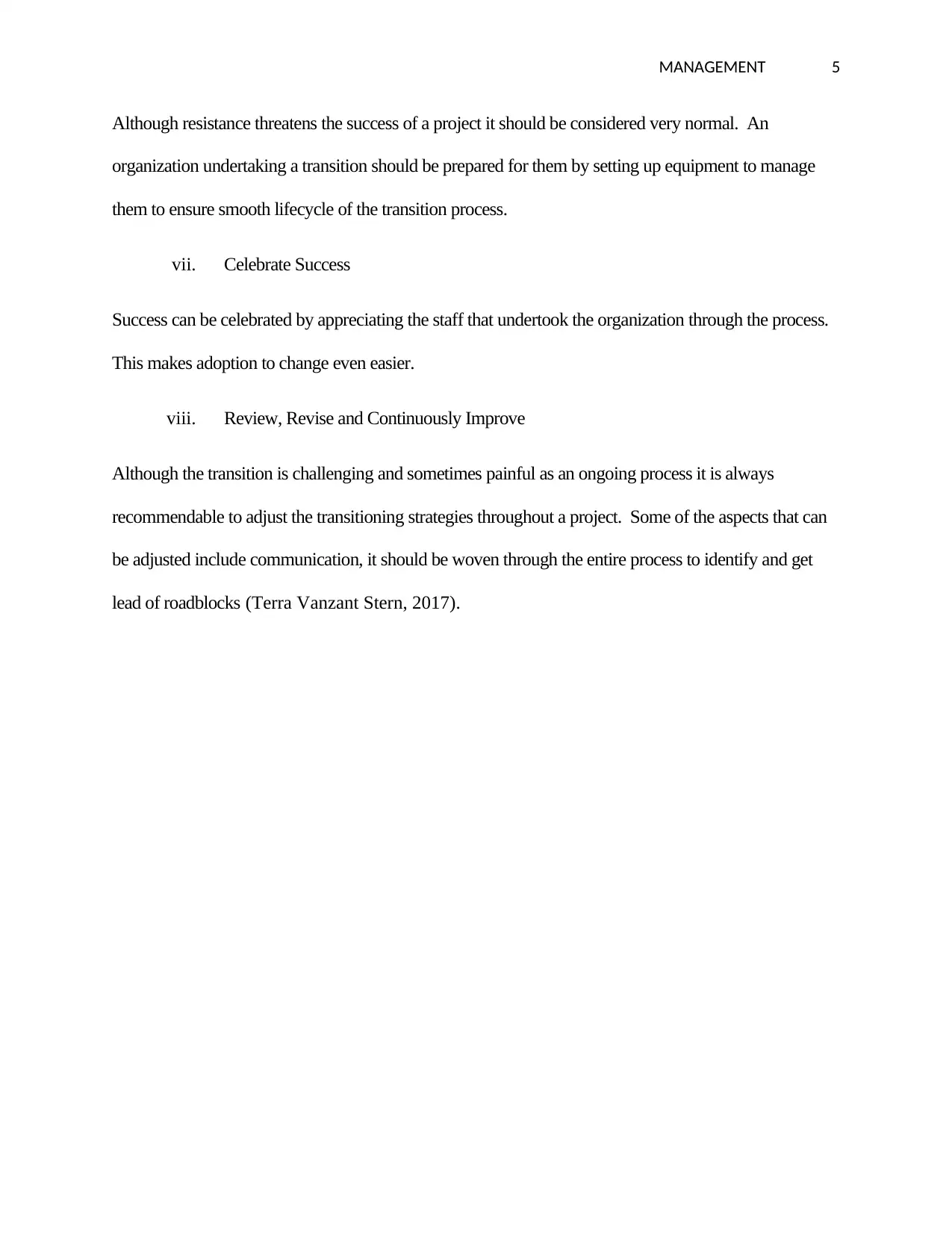
MANAGEMENT 5
Although resistance threatens the success of a project it should be considered very normal. An
organization undertaking a transition should be prepared for them by setting up equipment to manage
them to ensure smooth lifecycle of the transition process.
vii. Celebrate Success
Success can be celebrated by appreciating the staff that undertook the organization through the process.
This makes adoption to change even easier.
viii. Review, Revise and Continuously Improve
Although the transition is challenging and sometimes painful as an ongoing process it is always
recommendable to adjust the transitioning strategies throughout a project. Some of the aspects that can
be adjusted include communication, it should be woven through the entire process to identify and get
lead of roadblocks (Terra Vanzant Stern, 2017).
Although resistance threatens the success of a project it should be considered very normal. An
organization undertaking a transition should be prepared for them by setting up equipment to manage
them to ensure smooth lifecycle of the transition process.
vii. Celebrate Success
Success can be celebrated by appreciating the staff that undertook the organization through the process.
This makes adoption to change even easier.
viii. Review, Revise and Continuously Improve
Although the transition is challenging and sometimes painful as an ongoing process it is always
recommendable to adjust the transitioning strategies throughout a project. Some of the aspects that can
be adjusted include communication, it should be woven through the entire process to identify and get
lead of roadblocks (Terra Vanzant Stern, 2017).
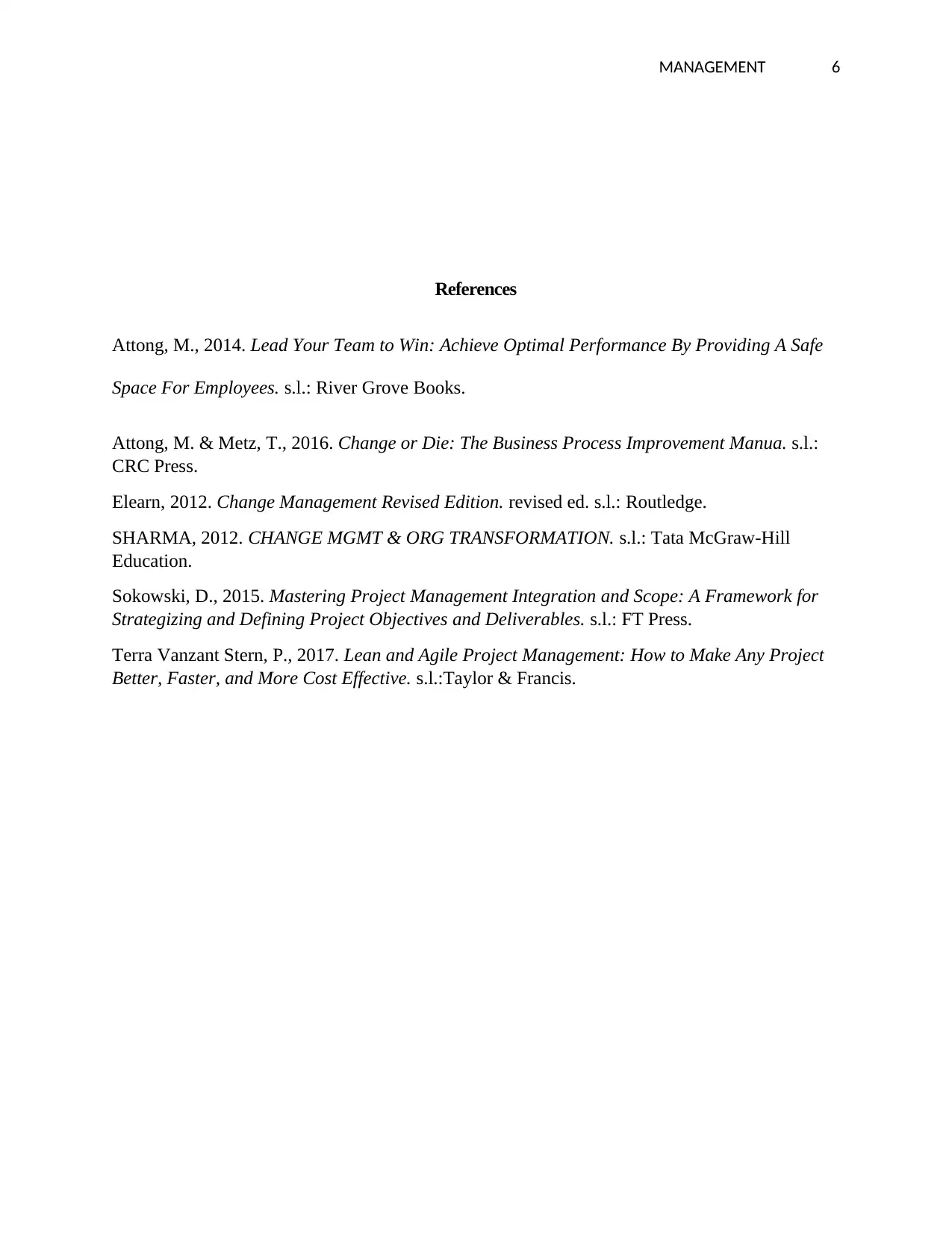
MANAGEMENT 6
References
Attong, M., 2014. Lead Your Team to Win: Achieve Optimal Performance By Providing A Safe
Space For Employees. s.l.: River Grove Books.
Attong, M. & Metz, T., 2016. Change or Die: The Business Process Improvement Manua. s.l.:
CRC Press.
Elearn, 2012. Change Management Revised Edition. revised ed. s.l.: Routledge.
SHARMA, 2012. CHANGE MGMT & ORG TRANSFORMATION. s.l.: Tata McGraw-Hill
Education.
Sokowski, D., 2015. Mastering Project Management Integration and Scope: A Framework for
Strategizing and Defining Project Objectives and Deliverables. s.l.: FT Press.
Terra Vanzant Stern, P., 2017. Lean and Agile Project Management: How to Make Any Project
Better, Faster, and More Cost Effective. s.l.:Taylor & Francis.
References
Attong, M., 2014. Lead Your Team to Win: Achieve Optimal Performance By Providing A Safe
Space For Employees. s.l.: River Grove Books.
Attong, M. & Metz, T., 2016. Change or Die: The Business Process Improvement Manua. s.l.:
CRC Press.
Elearn, 2012. Change Management Revised Edition. revised ed. s.l.: Routledge.
SHARMA, 2012. CHANGE MGMT & ORG TRANSFORMATION. s.l.: Tata McGraw-Hill
Education.
Sokowski, D., 2015. Mastering Project Management Integration and Scope: A Framework for
Strategizing and Defining Project Objectives and Deliverables. s.l.: FT Press.
Terra Vanzant Stern, P., 2017. Lean and Agile Project Management: How to Make Any Project
Better, Faster, and More Cost Effective. s.l.:Taylor & Francis.
⊘ This is a preview!⊘
Do you want full access?
Subscribe today to unlock all pages.

Trusted by 1+ million students worldwide

MANAGEMENT 7
1 out of 7
Related Documents
Your All-in-One AI-Powered Toolkit for Academic Success.
+13062052269
info@desklib.com
Available 24*7 on WhatsApp / Email
![[object Object]](/_next/static/media/star-bottom.7253800d.svg)
Unlock your academic potential
Copyright © 2020–2025 A2Z Services. All Rights Reserved. Developed and managed by ZUCOL.





